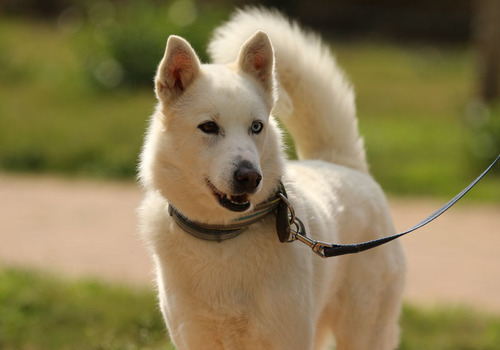The Siberian should look “well furred” according to the breed standard, and indeed he does. He has a medium-length double coat. The soft, dense undercoat is topped with straight guard hairs that lie smooth. That double coat means that the Siberian sheds. Oh, yes, he sheds. He sheds throughout the year; once or twice a year he undergoes a process called “blowing coat,” which is just what it sounds like. During this period you may feel that it is snowing gray and white hair. A shedding blade or coat rake will become your best ally.
That said, the Siberian is actually pretty easy to groom. Outside of shedding season, brush him occasionally with a slicker brush to remove dead hair. Trim the hair between the foot pads. That’s all. A bath is almost never necessary. The Siberian is a very clean dog with little to no odor.
Check the ears on a weekly basis for signs of infection, irritation, or wax build up. Cleanse regularly with a veterinarian-approved cleanser and cotton ball. Brush the teeth at least once per week to prevent tartar buildup and fight gum disease. Additionally, nails should be trimmed once per month if the dog does not wear the toenails down naturally.
Siberians are active, athletic dogs who need a lot of exercise. They are a working breed and happiest when they have a function to perform. Regular exercise is important both physically and mentally, and doing activities together strengthens the bond between dog and owner. Siberians were bred to run and will do so at every opportunity; it is vital to keep the dog on a leash, in harness, or in a fenced yard at all times.
Siberians need to let off steam whenever they can to get rid of all that pent up energy and they love romping around a back garden. However, the fencing has to be ultra-high and extremely secure to keep a Husky in because if they find any weaknesses in the fencing or discover they can dig their way under it, a Siberian Husky will get out and would get themselves into all sorts of trouble.
With this said, young puppies should not be given too much exercise because their joints and bones are still growing and too much pressure on them could result in causing a dog a few problems later on in their lives.
Fats and protein are the most important sources of energy to a Siberian Husky. You can feed your Husky a top quality dry dog food, but feel free to is critical to supplement with ground chicken, fish, liver or other meat products.
If you get a Siberian Husky puppy from a breeder, they would give you a feeding schedule and it's important to stick to the same routine, feeding the same puppy food to avoid any tummy upsets. You can change a puppy's diet, but this needs to be done very gradually always making sure they don't develop any digestive upsets and if they do, it's best to put them back on their original diet and to discuss things with the vet before attempting to change it again.
Older dogs are not known to be fussy or finicky eaters, but this does not mean you can feed them a lower quality diet. It's best to feed a mature dog twice a day, once in the morning and then again in the evening, making sure it's good quality food that meets all their nutritional requirements. It's also important that dogs be given the right amount of exercise so they burn off any excess calories or they might gain too much weight which can lead to all sorts of health issues. Obesity can shorten a dog's life by several years so it's important to keep an eye on their waistline from the word go.
Treatscan be an important aid in training, but giving too many can cause obesity. Learn about whichhuman foodsare safe for dogs, and which are not. Check with your vet if you have any concerns about your dog’s weight or diet.Clean, fresh water should be available at all times.
The average life span of the Siberian Husky is 10 to 14 years.The Siberian Husky breed is generally a healthy one.There are still a few concerns to watch out for, includingcrystalline corneal opacity, epilepsy,hip dysplasia,hypothyroidism, juvenilecataracts, osteochondritis dissecans (OCD), nasal depigmentation, oral eosinophilic granuloma,basal cell tumor, perianal gland adenoma, chronic superficial keratitis (pannus), Vogt-Koyanagi-Harada-like syndrome,progressive retinal atrophy (PRA)andvon Willebrand disease.
Husky owners claim their dogs have the ability to perform at the top of their obedience classes, but when they come home they ignore everything they learned, only to turn it back on again when they return to the next class. This breed is notoriously difficult to train and are generally not well suited for first-time owners. Huskies require firm leadership and 100% consistency when it comes to boundaries and rule enforcement. Their expressive eyes can be used to manipulate the softies of the house, so all family members must also be “trained” to be consistent with rules and leadership.
When it comes to socialization, the Siberian Husky integrates well with other animals and humans. Try to keep your Siberian Husky busy with activities to keep it happy.













